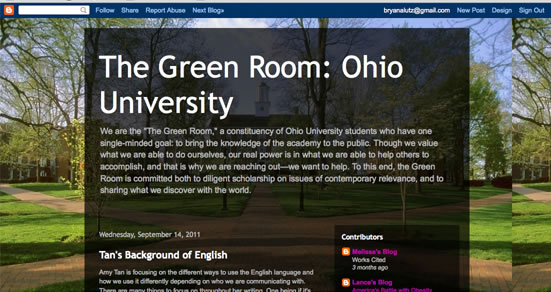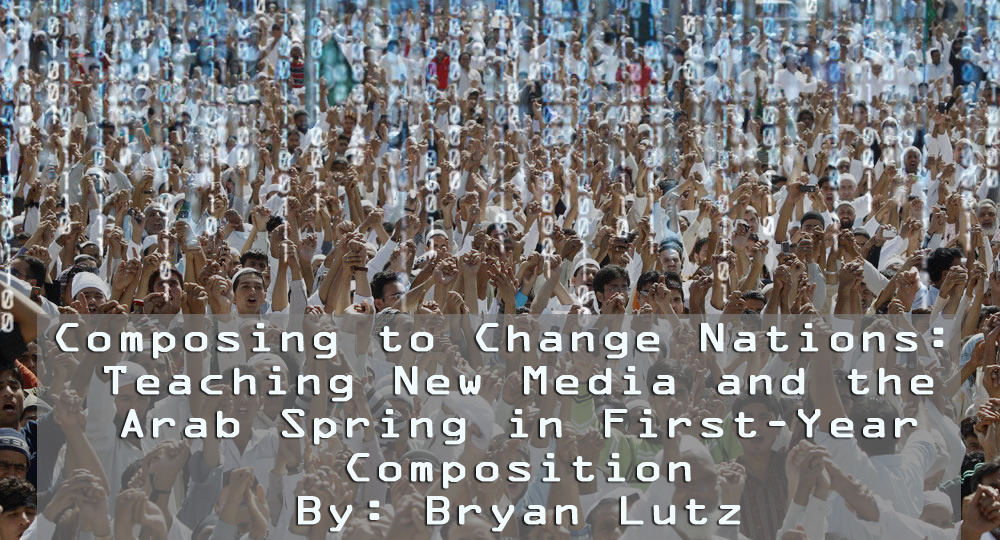Assignment
Goal #1: Identity, The Green Room at Ohio University
 |
| The Green Room at Ohio University |
According to the Civic Voluntarism model social movements are comprised of people with a common identity and common goals. In Tunisia and Egypt the unifying identity of nationhood, which was defined from their establishmed governments, became the platform necessary for advocacy. Their identities are more complex than what can be addressed in this work, but on the surface these identities reflected both the geography and culture of where they reside. Therefore if my freshmen are to consider themselves agents of change, then they need an identity that expresses both where they are and who they are as students. To this end I created “The Green Room,” a blog on blogger.com.
The Green Room serves as the unifying identity. The color green is our school color and the “room” represents the digital space where we collaborate as a class. This blog will serves two primary functions: first as a digital representation of our shared identity, and second, as a platform to share our blog essays. The blog provides a template where the class can author our its identity through reader-response criticism and rhetorical analysis. I share with them written arguements from our course texts as well as video arguments from TED.com and Youtube. Class discussion is driven by critical engagement. I ask students to respond to the provided arguments with their own lived experience and literacy in mind, and I challenge them to interpret how the arguments work upon them by usings the rhetorical schemes of the course. The students respond to these compositions through assigned reading tasks and during class discussion. This practice aims to help students to develop an awareness of whom they identify with and where they may place themselves in conversations on a range of social issues. This exposure to multiple points of view will serve as the foundation for their research process. Once their research is complete, they create their own blog that will that will provide students both with a place to compose, and with a URL that will host their messages. The students will then post their rough drafts on the Green Room, where repeat this process with their own devloping arguments (I may provide a guided peer-review depending on the class' engagement). The students engage each other in a dialogue within this space by posting their reactions to each others early draft in the comments section of their respective blogs. This process is aligned with earlier work with blogging by allowing students to help each other to refine their understandings through collaboration evalution, rhetorical criticism, and reader-response.
After the peer-review session we move on to "Advocacy Day," which is a class session dedicated to guiding students through the process of sharing their work with audeinces outside the class. The students use their blog URL as a way to share their multimodal arguments either through the comments sections of their chosen blogs, through the contact information on the websites of advocacy groups, or through their own Facebook and Twitter accounts. In practice their own blogs serve as digital space where they will engage others who are aligned with the student's evolving values and understandings, and the Green room serves as the hub for . I find that the combination of these elements allows us to negotiate their own identity as individuals, as OU students, and as scholars of rhetoric and composition. Since social networking attracts feedback and peer review (Chong, 2010, pp.799), the responses that students solicit serve to help students develop an understanding of how to situate themselves amongst global conversation of social justice and change. One student who identifies with the city of Athens showed how her community's environment will be impacted by hydraulic "fracking." Another, though not a mother herself, engaged in a dialogue about how mothers can use blogs to identify with each other and share the joys and diffculties of parenthood in ways that are perhaps therapeutic. These student's essays are two examples of how students negotiate identity between themselves, the instructor, their classmates, and the social movements they identify with, as well as situate themselves both within and apart from the composition classroom. Much like in the Arab Spring, students are, in part, participating in developing a broader social awareness while also working for the kinds of change they feel represents them.
